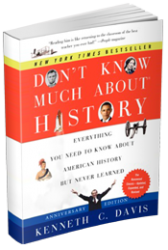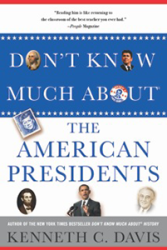The Month That Changed The World: 1945, 75 Years Ago
[Revised and updated repost of 2016 essay]
From “Trinity” to V-J Day
The Month That Changed the World

The Atomic Bomb Dome-Hiroshima (Photo Courtesy of Hiroshima and Nagasaki Remembered)
On August 6, 1945, the New York Times asked:
“What is this terrible new weapon?”
(New York Times, August 6, 1945: “First Atomic Bomb Dropped on Japan”)
The story followed the announcement made by President Harry S. Truman:
“SIXTEEN HOURS AGO an American airplane dropped one bomb on Hiroshima, an important Japanese Army base. That bomb had more power than 20,000 tons of T.N.T. It had more than two thousand times the blast power of the British ‘Grand Slam’ which is the largest bomb ever yet used in the history of warfare.”
August 6, 1945
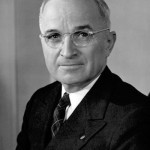
President Harry S. Truman
(Photo: Truman Library)
(“Statement by the President Announcing the Use of the A-Bomb at Hiroshima”: Truman Library and Museum)
ON July 16, 1945, the first atomic device, nicknamed “the Gadget,” was detonated in the “Trinity” test at Alamogordo, New Mexico. Read this excellent account of the test in National Geographic.
In the course of the next weeks, the world would be transformed, with the arrival of the Atomic Age, Japan’s surrender, the end of World War II, the charter of the United Nations, and the beginning of the Cold War.
July 17: In Potsdam, near Berlin in defeated Germany, Harry S. Truman came face to face with the Soviet dictator Joseph Stalin. Truman had taken office upon the death of President Roosevelt on April 12 without knowledge of the Manhattan Project or the atomic bomb’s existence. After he was told about the potential weapon, he was informed of the successful “Trinity” test while meeting with Churchill and Soviet Union leader Joseph Stalin at the postwar conference in Potsdam.
“I told Stalin that I am no diplomat but usually said yes or no to questions after hearing all the argument.”
Following the successful detonation in New Mexico, the components of the atomic bomb were loaded on the USS Indianapolis and transported to an airbase on Tinian Island in the Pacific. Many of the crew of nearly 1,200 men had no idea what the ship was carrying.
Jul7 24: Truman informed Stalin of a “new weapon of unusual destructive force.” But Stalin already know about the atomic bomb because of a network of spies inside the Manhattan Project.
July 26: Prime Minister Winston Churchill was defeated in the general election and replaced by Clement Attlee as Prime Minister.
“The landslide victory comes as a major shock to the Conservatives following Mr Churchill’s hugely successful term as Britain’s war-time coalition leader, during which he mobilised and inspired courage in an entire nation.”
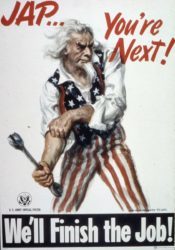
U.S. Propaganda poster (Source National Archives https://catalog.archives.gov/id/513563)
–BBC
At the Potsdam Conference, the Potsdam Declaration demanded “Unconditional surrender” by Japan. It threatened:
“The alternative for Japan is prompt and utter destruction.”
The Indianapolis reached Tinian that day.

USS Indianapolis 10 July 1945, after final overhaul and repair of combat damage. Photograph from the Bureau of Ships Collection in the U.S. National Archives (Naval History and Heritage Command https://usnhistory.navylive.dodlive.m...)
“Indianapolis departed San Francisco on 16 July 1945, foregoing her post-repair shakedown period. Touching at Pearl Harbor on 19 July, she raced on unescorted and reached Tinian on 26 July, covering some 5,000 miles from San Francisco in only ten days.”
After the delivery of the atomic bomb components, the ship sailed for Guam and the Philippines. On July 30, the ship was torpedoed by a Japanese submarine and sank in twelve minutes.
“What followed was an ordeal of hell on earth for those who survived the sinking. For a whole host of reasons, many related to the secrecy of her atom bomb mission, the rest of the Navy did not know that Indianapolis was missing.”
— Sam Cox (Rear Adm., USN, Ret.), “Lest We Forget: USS Indianapolis and her sailors”
July 29: The Japanese government rejected the surrender demand.
July 31: The assembly of the atomic bomb, code named “Little Boy,” was completed. The final arming of the bomb would be done in-flight.

In Potsdam, President Truman was notified of the bomb being ready. He wrote a message that concluded:
“Release when ready, but not sooner than August 2. HST”
According to the Truman Library:

The actual reply that President Truman wrote on July 31, 1945 (Photo taken by Dawn Wilson at the Harry S. Truman Presidential Library)
“No known written record exists in which Harry Truman explicitly ordered the use of atomic weapons against Japan. The closest thing to such a document is this handwritten order, addressed to Secretary of War Henry Stimson, in which Truman authorized the release of a public statement about the use of the bomb. It was written on July 31, 1945 while Truman was attending the Potsdam Conference in Germany. In effect, this served as final authorization for the employment of the atomic bomb, though the expression ‘release when ready’ refers to the public statement.”
August 1: the atomic bomb was ready and flight orders were prepared. But weather delayed the mission. Of four potential target cities, Hiroshima was chosen as the primary target.
In Potsdam that day, the Big Three were wrapping up their meetings and discussed plans for the trials of war criminals that later become known as the Nuremberg Trials.
In the Pacific, hundreds of survivors from the Indianapolis were desperately trying to stay afloat in the shark-infested waters.
“In that clear water you could see the sharks circling. Then every now and then, like lightning, one would come straight up and take a sailor and take him straight down.” – Survivor of the Indianapolis sinking to the BBC.
August 2: The U.S. Navy was still unaware that the Indianapolis had gone down. About 800 men had gone into the water and the survivors were spotted by a reconnaissance plane four days after the sinking; 317 survivors were rescued.

The Big Three at the end of the Potsdam Conference: Front row (Left to Right) Prime Minister Attlee, President Truman, Generalissimo Stalin. Source: Army Signal Corps Collection in the U.S. National Archives.
Shortly after midnight on August 2, the Potsdam Conference concluded with a joint communique. It included reference to the United Nations, whose organization and charter had been completed on June 26 at a conference in San Francisco.
Truman spoke of a future Washington meeting, but he and Stalin never met again.
What was clear was that the Conference had solidified the Soviet Union’s domination over much of Eastern Europe, including the eastern half of a divided Germany. Admiral William D. Leahy, Truman’s Chief of Staff, later wrote:
“The Soviet Union emerged at this time as the unquestioned all-powerful influence in Europe….”
August 4: Colonel Paul Tibbets briefed the men of the 509th Composite Group -the weapon delivery arm of the Manhattan Project. Tibbets was the commander of the unit. His men do not know the nature of the bomb they will carry.
August 5: The bombing mission was confirmed and Colonel Paul Tibbets announced he would pilot the plane which he named “Enola Gay,” after his mother. “Little Boy” was loaded on the plane.

Colonel Paul W. Tibbets, Jr., Pilot of the Enola Gay, the Plane that Dropped the Atomic Bomb August 6, 1945 (National Archives https://catalog.archives.gov/id/535737)
August 6 8:15 AM local time: The first atomic bomb was detonated over Hiroshima.
“In less than one second, the fireball had expanded to 900 feet. The blast wave shattered windows for a distance of ten miles and was felt as far away as 37 miles. Over two-thirds of Hiroshima’s buildings were demolished. The hundreds of fires, ignited by the thermal pulse, combined to produce a firestorm that had incinerated everything within about 4.4 miles of ground zero.”
Source: Hiroshima and Nagasaki Remembered.
“In the street, the first thing he saw was a squad of soldiers who had been burrowing into the hillside opposite, making one of the thousands of dugouts in which the Japanese apparently intended to resist invasion, hill by hill, life for life; the soldiers were coming out of the hole, where they should have been safe, and blood was running from their heads, chests, and backs. They were silent and dazed.
Under what seemed to be a local dust cloud, the day grew darker and darker.”
–John Hersey, “Hiroshima,” New Yorker (August 24, 1946)
In Hiroshima, the estimated death toll was eighty thousand people killed instantly; as many as 90 percent of the city’s nurses and doctors also died instantly. By 1950, as many as 200,000 had died as a result of long-term effects of radiation.
In his official announcement, President Truman said,
It was to spare the Japanese people from utter destruction that the ultimatum of July 26 was issued at Potsdam. Their leaders promptly rejected that ultimatum. If they do not now accept our terms they may expect a rain of ruin from the air, the like of which has never been seen on this earth. Behind this air attack will follow sea and land forces in such numbers and power as they have not yet seen and with the fighting skill of which they are already well aware.
August 8: The Soviet Union declared war on Japan and invaded Manchuria the next day, sending more than one million troops into the Japanese-held territory.
August 9: A second device, a plutonium bomb code named “Fat Man,” was used against the city of Nagasaki.
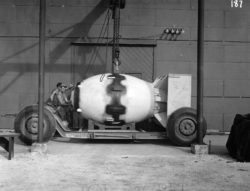
Fat Man being lowered and checked on transport dolly for airfield trip Image Source: Heritage Foundation https://www.atomicheritage.org/histor...
The death toll in Nagasaki also reached 80,000 by the end of 1945.
August 14 (August 15 in Japan): Japan announced its surrender. At a White House conference, according to United Press International, Truman said:
“This is the day when Fascist and police governments cease to exist in the world. This is the day for democracy.”
-Source: “Japan Surrenders Unconditionally, World At Peace” UPI archives

Truman announces Japan’s surrender to reporters in Oval Office.
Credit: Rowe, Abbie National Park Service Harry S. Truman Library & Museum.
Across America and England, jubilant crowds filled the streets once more for an unofficial V-J (Victory over Japan) Day, as they had on VE Day, May 8,1945, after Germany’s surrender ended the war in Europe.

V-J Day Times Square August 14, 1945 Library of Congress Prints and Photographs Division. New York World-Telegram and the Sun Newspaper Photograph Collection. http://hdl.loc.gov/loc.pnp/cph.3c19650
September 2, 1945: A formal surrender ceremony was performed in Tokyo Bay and that date is also referred to as V-J Day.
Almost since the day the first atomic bomb was dropped on Hiroshima, critics have second-guessed Truman’s decision and motives. A generation of historians and commentators have defended or repudiated the need for unleashing the atomic weapon. Admiral William D. Leahy, who was with Truman at Potsdam, later wrote in a memoir:
Once it had been tested, President Truman faced the decision as to whether to use it. He did not like the idea, but he was persuaded that it would shorten the war against Japan and save American lives. It is my opinion that the use of this barbarous weapon at Hiroshima and Nagasaki was of no material assistance in our war against Japan.
–William D. Leahy, I Was There (1950)
You can read more about Hiroshima and the dropping of the atomic bombs in Don’t Know Much About Historyand more about President Truman in Don’t Know Much About the American Presidents and in The Hidden History of America At War.
Read more about Mussolini, Hitler, and Stalin in STRONGMAN which will be published on October 6, 2020.
